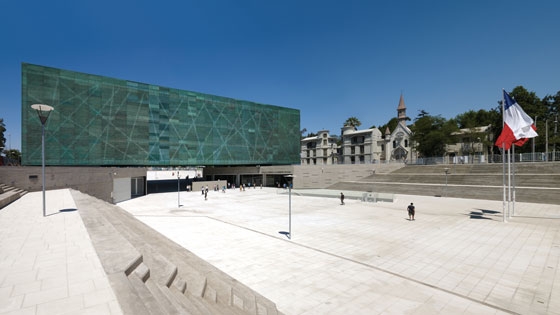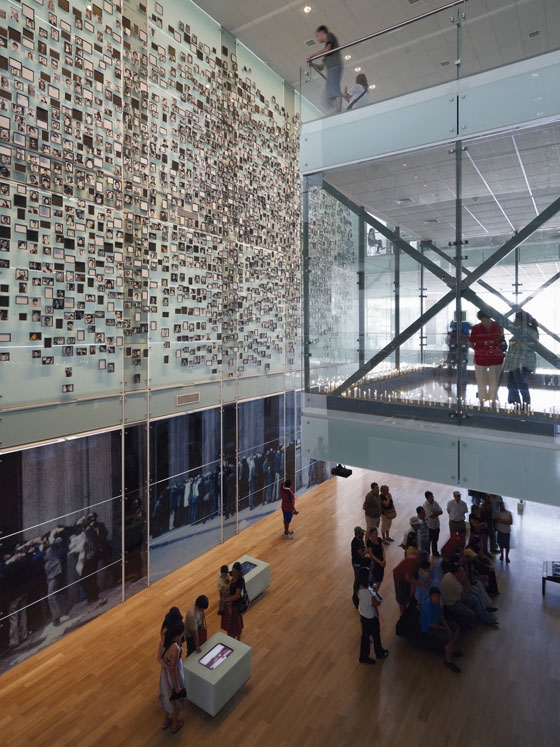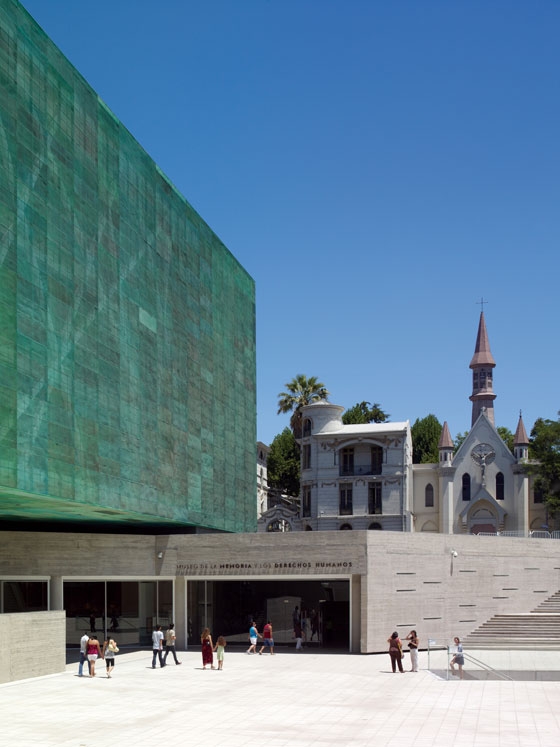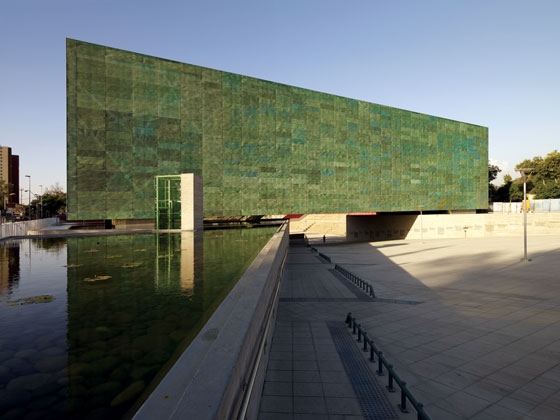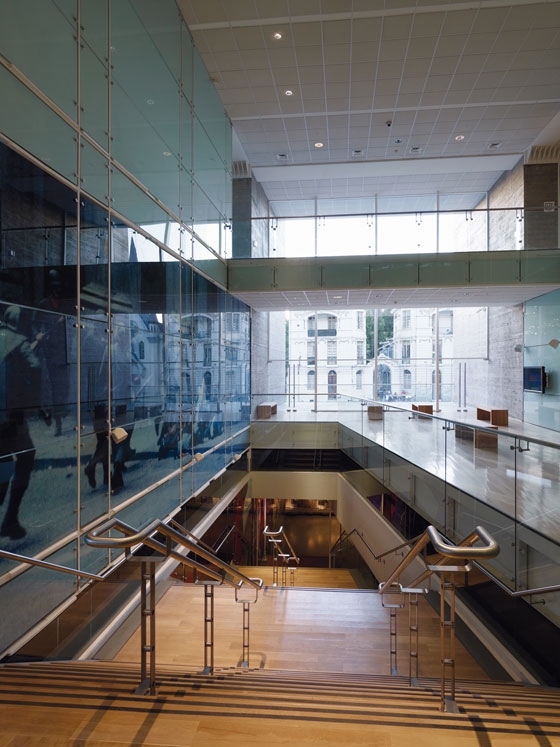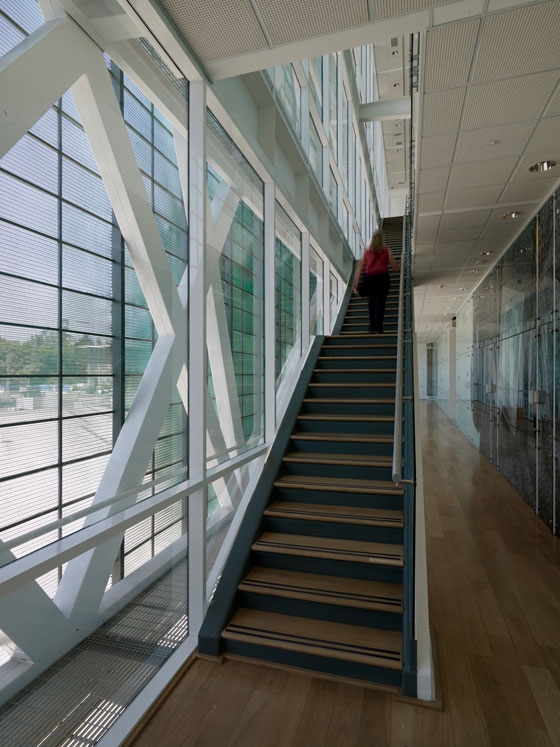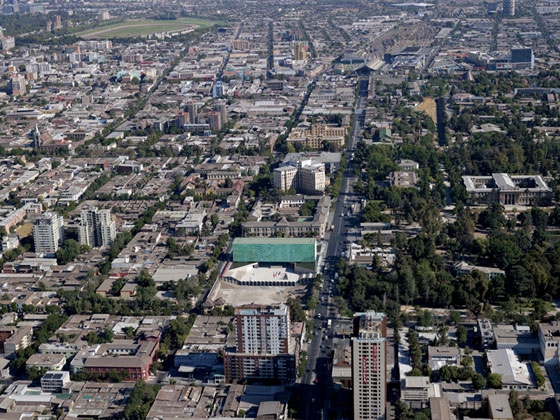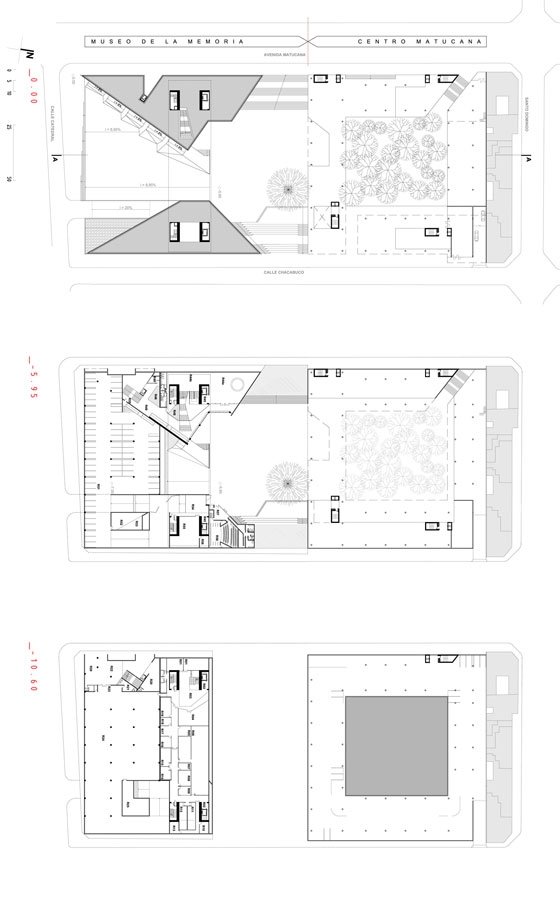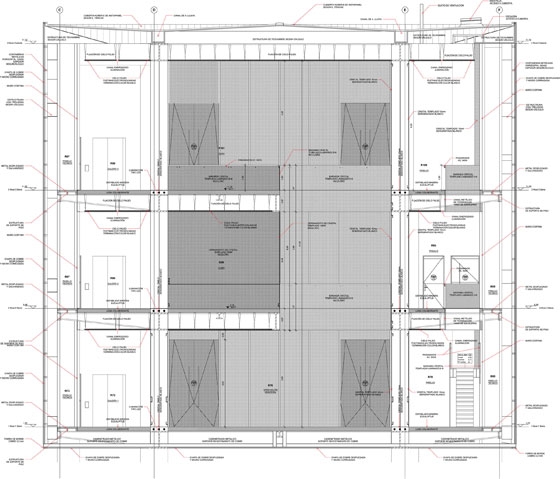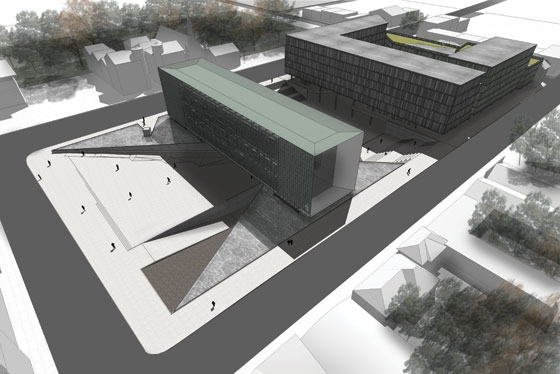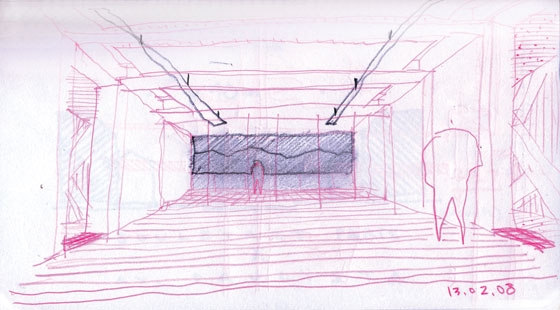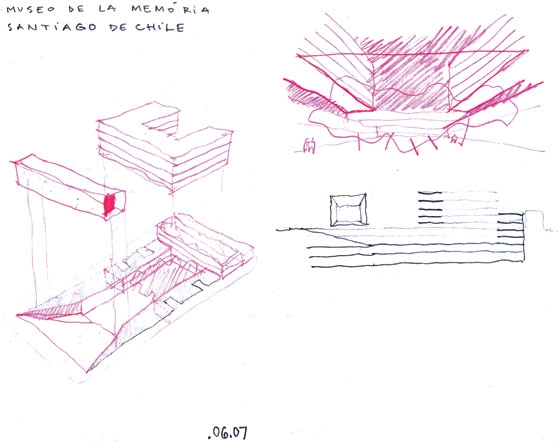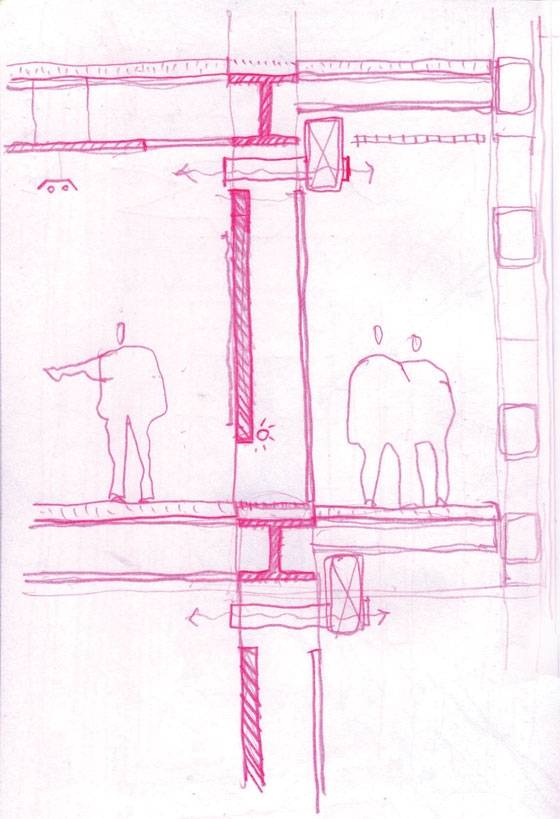CONCEPT
Memories are figures that live in an unconcluded world. They are fragments of unrepeatable facts, that never happen twice. We don’t understand memory as a juvenile desire to go backwards, to replace the irreplaceable; memory is not repent for us. It is to look at the future knowing of the past.
A Museum of Memory should be imagined from the non linear character of time and its images. And also how we can hold and transmit this knowledge in a broad and impartial way.
A singular country, between the mountain chains of the Andes and the sea. A museum willing to occupy this band of earth, in homage, through a symbolic view, to these two determinant elements of Chilean geography, marked in the soul of its people.
The memory in evidence, emerging, floating, smoothly elevated. An ark where all the reminiscences of Chilean history can be deposited.
Designed to create physical or mental places from where it’s possible to offer conditions [operative surroundings] so that knowledge germinates interiorly in every individual. Only what is realized personally by each one can be accumulated as active memory. A space dedicated to memory can, not only transmit information, but also provoke the reflection about remembrances and desires.
The territorial order of downtown Santiago is intimately connected to the historical city, it understands the public space as not built, configured by the perimetrical occupation of the square. We understand this history and its tradition, but we consider the possibility of advancing in the construction of a new territory, which has a clear compromise with the citizens’ diversity and the democratic spaces.
Matucana Center will be an open square. It understands and harmonizes itself with the inherited city, incorporating and changing it. The Museum of Memory won’t be an isolated monument, loose and lacking urban [and human] responsibility. On the contrary, it will be an element compromised directly with the delimitation and characterization of this new public space of Santiago.
A generous space is proposed, full of possibilities and pathways. It permits the natural and daily transposition of the square. The urban elements that compose Matucana Center have a civic character. The great ramp of the Museum, the ‘Plaza de la Memoria’, the garden patio constitute a spatial sequence that offers a necessary urban hierarchy for a metropolitan complex.
The public and private offices are organized around a garden, the ‘Patio de los Deseos’. The built body recomposes the traditional urban configuration, but it also permits, through an elevated ground floor, the desired and necessary permeability. The height adjustments of the buildings, proposed to the north border, offer more than a transition from the historical buildings and the Matucana Center, it offers also the possibility of an aerial extension of the garden patio through the garden terraces.
TECHNIQUE AND MATERIALITY
The structure of the exposition beam presents itself integrally unique; without concessions it is an evidence of the elevation of memory. There will be an ethereal materiality, like a stone of Magritte. This way, like a tunnel, a metal patchwork presents itself as structure. The support of the elevated building’s body is located in four pillars incorporated to the vertical circulations on each edge. Over this great free span, the translucid exposition boxes, protected by the distance to the lateral borders, guarantee a controlled lighting for the Museum.
The materiality is also achieved with components that greatly represent the natural products of Chilean territory. The wooden floor generates contrast with the bright tones of the ceilings and the glass walls, paginated in a way that the internal Vierendeel steel beams [main structure] are apparent. Each part of the exposition space calls the eye to the relation with the city, and the two different views of the landscape. For the external surfaces, copper and coal mark the history of Chilean mining, as a memory of the economy, of doing and of living. The Museum is like a crystal stone which has in its steel the essential carbon for the existence of the human being and nature. Symbolically, the carbon is the register of what has been. It is also the memory of what could have been.
We worry persistently with our future, with conservation and the environment. The natural light shines in different ways, portraying different situations in the interior space, drawing and living new places in a trajectory of effects always much unexpected. The light is reflected by the great ramp and the inner square [‘Plaza de la Memoria’], entering the building and its base in indirect ways.
The elements of nature in a kaleidoscope of effects over man added to the memory as a manifestation of human construction, delineate the land and its memory as manifestations of the culture and the appropriation of the space that is, absolutely, the life included in this project.
THE PROGRAM
A group of buildings absorb the offices [public and private], the commercial uses and services, organized around a garden situated in front of the ‘Plaza de la Memoria’ containing stores, bars and restaurants, delicacies of the human nature, waiting for the meetings, the casual encounters and smiles.
The Museum is conceptually organized in two moments: the Exposition Beam and the Base. The first, elevated, the history, the information, the act of living memory, open on both ends, like someone who lets life pass, naturally. The other, the Base, in a first step deep as a mine, where the study, the production, the invention, the seminars, the knowledge of the land and the territory are located; in another step, the necessary support by the administration sectors. The Beam as a specific museographical space and the Base as a museological one, a place of study and support.
Along both sides of the Exposition Beam are the circulations, bathrooms and support systems, lightened by the translucency of the perforated copper plates and the second external skin, made of transparent glass, thus creating a totally controlled inner environment. On a second effect, the light also penetrates all the exposition space through the semi-opaque glass walls.
The manifestation, the flourishing of this knowledge is the contemporary objective of a museum. It appears from deep, well planted roots in the underground [the Base], from where the energetic, productive, mineral potentials appear; the solidity has the opportunity to manifest itself.
In the interior, the glass boxes, the necessary transparency, the vivacity; the memory lived in fragments, each one forming, altogether, the repertory of the idiosyncrasy of a nation. The mass is crystal.
Terrain Area COMPETITION:
15.727 m²
Built Surface
Competition > 49.150 m² [Museum + Matucana Center + Parking Lot]
Executive Design > 10.900 m² [Museum + New Parking Lot]
Project
2007 [competition]
2007 > 2008 [executive design]
Construction
from December 20, 2008 to December 10, 2009
MOP (Chilean Ministry of Public Works), Dirección de Arquitectura, Comisión Presidencial de los Derechos Humanos
Authors: ESTUDIO AMERICA
Carlos Dias, Lucas Fehr y Mario Figueroa [Brasil] + Roberto Ibieta [responsible technician and associated architect in Chile]
Collaborators COMPETITION:
Amanda Renz, Carlos Eduardo Garcia, Flávia Tenan, Juliana Baldocchi, Juliana Klein, Marcus Vinícius Damon and Marina Canhadas + Eng. Ricardo Dias [structure consultant] and Josei Nagayassu
Collaborators EXECUTIVE DESIGN:
Brazil: Amanda Renz, Carlos Eduardo Garcia, Juliana Klein, Marcus Vinícius Damon and Marina Canhadas + Luiz Del Guerra and Gustavo Capecchi
Chile: Werner Renck [coordinating architect], Luis Madrid [architect], Ignacio Cárdenas [architect], Felipe Gonzalez [architect], Cristián Pérez [engineer], Álvaro Díaz [technical designer]
Technical Assessoring
Eng. Osvaldo Peñaloza [structure]
Termosistemas [acclimatization]
Sipar [sanitation]
Pimesa [electricity]
Eng. Jaime Hurtado [lighting design]
Civil Constructor Sergio Dalmazzo [security]
Piscinería [hydraulics]
SolArchi [general coordination]
Constructors
COMSA de CHILE
BASCO
Metal Structure
Maestranza JOMA
